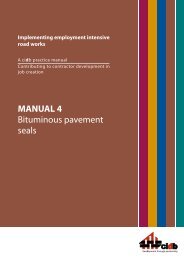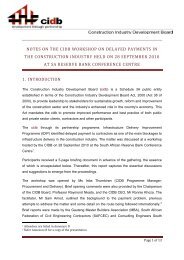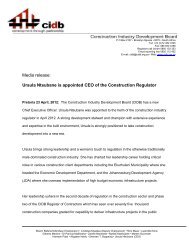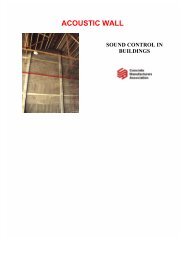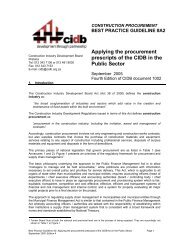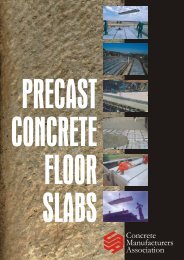Clay brick manufacture - Construction Industry Development Board
Clay brick manufacture - Construction Industry Development Board
Clay brick manufacture - Construction Industry Development Board
Create successful ePaper yourself
Turn your PDF publications into a flip-book with our unique Google optimized e-Paper software.
Provided that a sand yields a smooth, plastic and cohesive mix, its quality, based on “water demand”<br />
can be determined by the following test.<br />
The quantities used should be weighed on a kitchen scale that is accurate, and the test should be<br />
carried out on a smooth impervious surface. It is also important that the sample used is fairly<br />
representative of the bulk supply.<br />
Procedure:<br />
• Dry out a wheelbarrow full of sand to be tested.<br />
• Weigh 5 kg cement and 25 kg of dry sand. Measure 5 litres, 1 litre and 1,5 litres water into separate<br />
containers.<br />
• Mix the cement and sand until the colour is uniform.<br />
• In succession, mix in each of the volumes of water (5 litres, 1 litre and 1,5 litres) until the mix<br />
Then:<br />
reaches a consistency suitable for plastering.<br />
• If 5 litres is enough – the sand is of “good” quality<br />
• If 5 litres + 1 litre is enough – the sand is of “average” quality<br />
• If 5 litres + 1 litre + 1,5 litres is enough – the sand is “poor”<br />
• If more than 7,5 litres is needed – the sand is “very poor”.<br />
A “good” or “average” sand should be used for mortar in walling below the damp-proof course.<br />
5.4.5 Mortar plasticisers<br />
Mortar plasticisers exercise a desirable effect on the workability and plasticity of the mortar in which<br />
they are used. Generally, the admixtures have no effect on setting time (they do not accelerate or<br />
retard the mortar setting) but may cause air entrainment.<br />
The use of mortar plasticisers is optional. Their effectiveness varies with the quality of sand, the<br />
composition of the cement, its fineness, the water-cement ratio, temperature of the mortar, volume of<br />
plasticiser and other factors or site conditions.<br />
5.4.6 Pigments<br />
Pigments may be used to colour mortar, with the dosage depending on the specific colour required.<br />
The recommended limit on mineral oxide content is 7% of common cement content. Pigmented mortar<br />
with face <strong>brick</strong>work can change the appearance of a building dramatically.<br />
5.4.7 Ready-mixed mortar<br />
Ready-mixed mortar with an extended board life has been successfully used over a number of years.<br />
Ready-mixed mortar has advantages of convenience on site as it is delivered at a consistency ready<br />
for use. Usually it is delivered in ready-mix trucks or containers. It is stored in containers on site in a<br />
protective manner that minimises loss due to evaporation and protects the mortar from freezing in<br />
cold weather. No other materials or admixtures are added on the site.<br />
32





